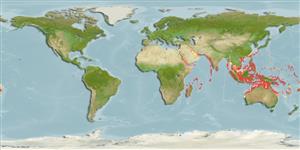Hexacorallia |
Scleractinia |
Faviidae
Environment: milieu / climate zone / djupintervall / distribution range
Ekologi
Revassocierade; djupintervall 3 - 56 m (Ref. 8294). Tropical; 30°N - 27°S, 32°E - 172°W (Ref. 848)
Indo-West Pacific: Bonin Islands to Australia and Red Sea to Kiribati.
Length at first maturity / Size / Weight / Age
Könsmognad: Lm ? range ? - ? cm
Maximum depth from Ref. 100940. In Palau, it has variable bleaching level and distinct variation in color upon bleaching (Ref. 66144).
Life cycle and mating behavior
Könsmognad | Reproduktion | Lek | Eggs | Fecundity | Larvae
Mature gametes are shed into the coelenteron and spawned through the mouth. Life cycle: The zygote develops into a planktonic planula larva. Metamorphosis begins with early morphogenesis of tentacles, septa and pharynx before larval settlement on the aboral end (Ref. 833).
Ross, M.A. and G. Hodgson 1981 A quantitative study of hermatypic coral diversity and zonation at Apo Reef, Mindiro, Philippines. Proceedings of the Fourth International Coral Reef Syposium, Manila 2:281-291. (Ref. 8294)
IUCN Red List Status
(Ref. 130435: Version 2025-1)
CITES status (Ref. 108899)
Not Evaluated
Threat to humans
Human uses
| FishSource |
Verktyg
Ytterligare information
Trophic EcologyFood items (preys)
Födosammansättning
Födointag
Predatorer
Population dynamicsTillväxtMax. ages / sizesLength-weight rel.Length-length rel.Length-frequenciesMass conversionAbundans PhysiologySyreförbrukning
Human RelatedStamps, coins, misc.
Internet-källor
Estimates based on models
Preferred temperature
(Ref.
115969): 25.4 - 29.3, mean 28.5 (based on 3105 cells).
Price category
Unknown.
